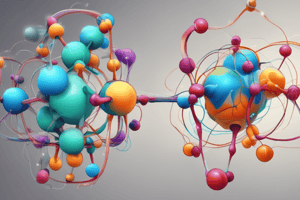Podcast
Questions and Answers
What type of bond is formed by the transfer of electrons from one atom to another?
What type of bond is formed by the transfer of electrons from one atom to another?
- Metallic Bonds
- Covalent Bonds
- Hydrogen Bonds
- Ionic Bonds (correct)
Which type of covalent bond involves the sharing of two pairs of electrons?
Which type of covalent bond involves the sharing of two pairs of electrons?
- Triple Covalent Bond
- Polar Covalent Bond
- Double Covalent Bond (correct)
- Single Covalent Bond
What influence does bond length have on bond strength?
What influence does bond length have on bond strength?
- Bond length does not affect strength
- Shorter bonds are generally stronger (correct)
- All bonds have equal strength regardless of length
- Longer bonds are generally stronger
Which molecular geometry has bond angles of 109.5°?
Which molecular geometry has bond angles of 109.5°?
In what type of intermolecular force do temporary dipoles play a key role?
In what type of intermolecular force do temporary dipoles play a key role?
Which hybridization involves one s and three p orbitals?
Which hybridization involves one s and three p orbitals?
What is the primary characteristic of metallic bonds?
What is the primary characteristic of metallic bonds?
What determines whether a bond is polar covalent?
What determines whether a bond is polar covalent?
Which molecular geometry is characterized by bond angles of 90° and 120°?
Which molecular geometry is characterized by bond angles of 90° and 120°?
In which type of bond does one atom exert a greater attraction on shared electrons, causing partial charges?
In which type of bond does one atom exert a greater attraction on shared electrons, causing partial charges?
Flashcards are hidden until you start studying
Study Notes
Chemical Bonding
Types of Bonds
-
Ionic Bonds
- Formed by the transfer of electrons from one atom to another.
- Typically occurs between metals and nonmetals.
- Results in the formation of charged ions (cations and anions).
- Characterized by high melting and boiling points.
-
Covalent Bonds
- Formed by the sharing of electrons between atoms.
- Commonly found between nonmetals.
- Types:
- Single Covalent Bond: One pair of electrons shared (e.g., H2).
- Double Covalent Bond: Two pairs of electrons shared (e.g., O2).
- Triple Covalent Bond: Three pairs of electrons shared (e.g., N2).
- Lower melting and boiling points compared to ionic compounds.
-
Metallic Bonds
- Formed by the attraction between free electrons and metal ions.
- Electrons are delocalized, creating a 'sea of electrons'.
- Responsible for properties like electrical conductivity and malleability.
Bond Polarity
- Nonpolar Covalent Bonds: Electrons are shared equally (e.g., Cl2).
- Polar Covalent Bonds: Electrons are shared unequally, resulting in partial charges (e.g., H2O).
- Determined by differences in electronegativity between bonded atoms.
Bond Strength
- Bond Length: Distance between nuclei of two bonded atoms; shorter bonds are generally stronger.
- Bond Energy: Energy required to break a bond; higher energy indicates a stronger bond.
Molecular Geometry
- Determined by VSEPR theory (Valence Shell Electron Pair Repulsion):
- Linear: 180° (e.g., CO2)
- Trigonal Planar: 120° (e.g., BF3)
- Tetrahedral: 109.5° (e.g., CH4)
- Trigonal Bipyramidal: 90° and 120° (e.g., PCl5)
- Octahedral: 90° (e.g., SF6)
Hybridization
- sp Hybridization: Involves one s and one p orbital, results in two equivalent orbitals (e.g., BeCl2).
- sp² Hybridization: Involves one s and two p orbitals, results in three orbitals (e.g., BF3).
- sp³ Hybridization: Involves one s and three p orbitals, results in four equivalent orbitals (e.g., CH4).
Intermolecular Forces
- London Dispersion Forces: Weak forces due to temporary dipoles; present in all molecules.
- Dipole-Dipole Interactions: Occur between polar molecules.
- Hydrogen Bonds: Strong dipole-dipole attractions between molecules with H bonded to F, O, or N.
Understanding these concepts is crucial for grasping the fundamentals of chemical behavior and properties of substances.
Types of Bonds
- Ionic Bonds: Formed by the transfer of electrons between atoms; occur between metals and nonmetals; result in charged ions (cations and anions); characterized by high melting and boiling points.
- Covalent Bonds: Formed by the sharing of electrons between atoms; commonly found between nonmetals.
- Single Covalent Bond: One pair of electrons shared.
- Double Covalent Bond: Two pairs of electrons shared.
- Triple Covalent Bond: Three pairs of electrons shared.
- Covalent bonds have lower melting and boiling points compared to ionic compounds.
- Metallic Bonds: Formed by the attraction between free electrons and metal ions; electrons are delocalized, creating a 'sea of electrons'; responsible for properties like electrical conductivity and malleability.
Bond Polarity
- Nonpolar Covalent Bonds: Electrons are shared equally.
- Polar Covalent Bonds: Electrons are shared unequally, resulting in partial charges.
- Bond polarity is determined by differences in electronegativity between bonded atoms.
Bond Strength
- Bond Length: Distance between nuclei of two bonded atoms; shorter bonds are generally stronger.
- Bond Energy: Energy required to break a bond; higher energy indicates a stronger bond.
Molecular Geometry
- Determined by VSEPR theory (Valence Shell Electron Pair Repulsion).
- Linear: 180°
- Trigonal Planar: 120°
- Tetrahedral: 109.5°
- Trigonal Bipyramidal: 90° and 120°
- Octahedral: 90°
Hybridization
- sp Hybridization: one s and one p orbital involved; results in two equivalent orbitals.
- sp² Hybridization: one s and two p orbitals involved; results in three orbitals.
- sp³ Hybridization: one s and three p orbitals involved; results in four equivalent orbitals.
Intermolecular Forces
- London Dispersion Forces: Weak forces due to temporary dipoles; present in all molecules.
- Dipole-Dipole Interactions: Occur between polar molecules.
- Hydrogen Bonds: Strong dipole-dipole attractions between molecules with H bonded to F, O, or N.
Studying That Suits You
Use AI to generate personalized quizzes and flashcards to suit your learning preferences.




